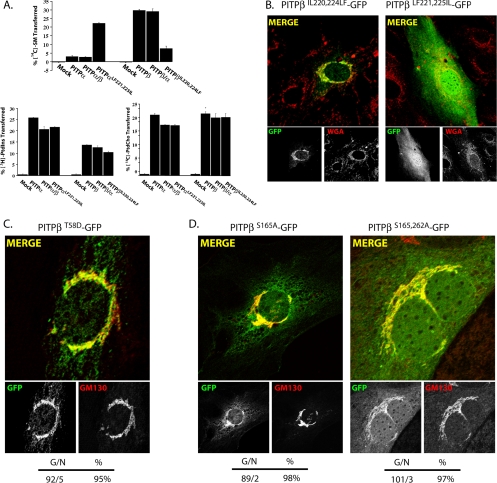Figure 5.
PITPβ localization to TGN membranes is independent of phospholipid loading. (A) Phospholipid-transfer properties of select PITP chimeras. Abilities of each individual PITP or PITP chimera to transfer [14C]-SM, [3H]PtdIns, or [14C]PtdCho (as indicated) was determined in cytosol fractions prepared from yeast strain CTY303 (sec14Δ cki1Δ) expressing recombinant versions of the respective PITPs (Phillips et al., 1999; Li et al., 2000). CTY303/YEp(URA3) cytosol was prepared and used as negative control. Activity is represented as the percentage of total input radiolabeled phospholipid transferred from donor membranes to unlabeled acceptor membranes during the course of the experiment. Assay blanks represented addition of buffer alone to the transfer assay reactions, and these background values were subtracted from the other measurements. Values represent the averages of triplicate determinations from a representative experiment, and at least three independent experiments were performed. In the experiment shown, input phospholipid-transfer substrate was 19,850 cpm [14C]SM; 21,050 cpm [3H]PtdIns; 21,250 cpm [14C]PtdCho. Background values for these respective transfer assays were 700, 315, and 820 cpm. A representative image of PITPα−/− MEFs expressing a (B) PITPβIL220,224LF-GFP or a PITPαLF221,225IL-GFP chimera. Cells were imaged for GFP and the pan-Golgi marker wheat germ agglutinin (WGA), as indicated. Corresponding merged profiles are shown. (C) PITPβT58D-GFP chimera. PITPβT58D-GFP and GM130 profiles are presented in the bottom panels underneath the corresponding merged profile. (D) PITPβS165A-GFP or a PITPβS165,262A-GFP chimera. Cells were imaged for GFP and GM130, as indicated. Corresponding merged profiles are shown. For C and D, quantification of number of cells displaying Golgi (G) or non-Golgi (N) localization profiles, along with the percentages of cells displaying Golgi localization, are given for each construct at the bottom of the corresponding panel set.

